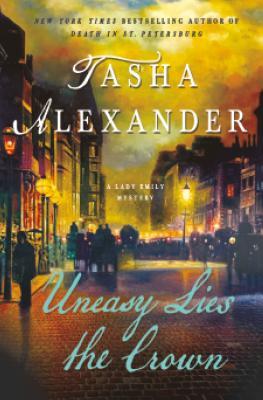
Uneasy Lies the Crown, by Tasha Alexander
Genre: historical mystery series
Publisher: Minotaur Press
Release Date: 2018
Summary:
“On her deathbed, Queen Victoria asks to speak privately with trusted agent of the Crown, Colin Hargreaves, and slips him a letter with one last command: Une sanz pluis. Sapere aude. “One and no more. Dare to know.”
“The year is 1901 and the death of Britain’s longest-reigning monarch has sent the entire British Empire into mourning. But for Lady Emily and her dashing husband, Colin, the grieving is cut short as another death takes center stage. A body has been found in the Tower of London, posed to look like the murdered medieval king Henry VI. When a second dead man turns up in London’s exclusive Berkeley Square, his mutilated remains staged to evoke the violent demise of Edward II, it becomes evident that the mastermind behind the crimes plans to strike again.
“The race to find the killer takes Emily deep into the capital’s underbelly, teeming with secret gangs, street children, and sleazy brothels–but the clues aren’t adding up. Even more puzzling are the anonymous letters Colin has been receiving since Victoria’s death, seeming to threaten her successor, Edward VII. With the killer leaving a trail of dead kings in his wake, will Edward be the next victim?” (from the Goodreads blurb of Uneasy Lies the Crown, by Tasha Alexander)
My thoughts
Honestly, in the first fifty-odd pages, I thought this was going to be a DNF. There was too much info-dumping about the historical era, not enough tension, and not enough revealed about the main characters’ personalities. I kept going, though, and things got better.
The blurb did not mention the dual timeline. Between chapters of the 1901 story, there is another story told, that of Colin’s ancestors, Cecily and William. In 1415, William heads off to fight with Henry V and Cecily is shipped off to the house of her old nemesis Adeline.
This is a series novel, so long-time readers of this series might not have the same issues as I did in the opening sections.
What didn’t work for me
The dual timeline
There are two timelines, told in alternating chapters.
One, in 1901, with the murders, follows Lady Emily and Colin as they hunt down the killer.
Two, in 1415, follows the Cecily-Adeline relationship and Cecily’s husband William as he fights on Henry V’s side in France.
The plot with William has lots of battles, deaths, and fierce fighting. I wasn’t terribly interested–battles aren’t my favorite part of history–but others might be. Still, at least it leads somewhere that connects with the 1901 story. The Cecily-Adeline story doesn’t.
From my observation, dual timelines work best when 1) the two stories connect somehow, and 2) the two storylines build suspense and tension for each other. While there is a loose connection between the two time periods, the sections feel like two separate stories sharing a book cover.
The Cecily-Adeline relationship
Honestly, I could have done without these sections. Neither character is terribly interesting. While the historical details about women’s lives during the 15th century are fascinating, the antagonistic relationship between these two characters isn’t. Moreover, the conflict builds over the course of the novel, only to fizzle when it needs to pop.
I’m not certain why the author included these sections, other than her obvious fascination with the Middle Ages. Maybe she intended there to be a connection between Lady Emily’s issues as a Victorian-turned-Edwardian woman and Cecily and Adeline’s issues as women. If so, the thematic connection isn’t made strongly enough.
The mystery
Having the 1901 murder mystery interrupted constantly made it difficult for me to follow Lady Emily and Colin’s investigation. I never felt like I got a good grasp on the killer’s motives and the climax felt anti-climatic. I finished that part and thought, “So what?”
What almost didn’t work
(or, why you should keep reading a book even if you don’t like the 1st 50 pages)
Lady Emily
The blurbs promised me that she was delightfully eccentric, unusual, etc. But for the first 50 pages or so, I didn’t see what was unusual about her.
Is she unusual for a Victorian era lady? Yes.
Is she unusual for a female sleuth in a historical mystery? Not really.
She’s strong-willed. Smokes and drinks. Flouts conventions. Likes having sex with her husband. If a police inspector tells her not to investigate, you can bet that she’s going to start snooping and digging and getting into trouble. For that last part at least, that is almost to be expected in a historical mystery novel written in the 21st century. Look at C.S. Harris’ Hero Jarvis, Laurie R. King’s Mary Russell, or Sujeta Massey’s Perveen Mistry.
I was also irritated that as she discusses the case with her husband, she drifts from intuition to imagination. Some of her imaginary scenarios were so fanciful that I wondered if she took the murder case seriously or used it as a way to amuse herself.
Fortunately, she did win me over. Eventually.
I did appreciate that she likes being a mother to three rowdy boys and doesn’t display antagonism toward the entire concept of being a wife and mother. It probably helps that she has a nanny and multiple staff members who are competent and ensure that she doesn’t have to clean, cook, or deal with household headaches.
Once I warmed to her, I mostly liked her voice as the first person narrator. She can come across as smug.
What worked for me
Jeremy, Duke of Bainbridge
(A.K.A., Lady Emily’s oldest friend)
I was contemplating putting down the book, but then Jeremy popped into the book. For some reason, I liked him. (Maybe he reminds me of a high school crush? Maybe I’m one of those women Emily scorns who swoon over dukes? Who knows?) As he chauffeured Emily to and from scandalous places in his bright blue Daimler motorcar, I kept reading.
Colin and Emily’s relationship
These two appear deeply in love and still on fire for each other. (No explicit sex–they are Victorians, after all!–but their lovemaking is alluded to.) They also seem to have worked out the balance of power in their relationship. They disagree and banter and care for one another.
The history
Alexander obviously knows her time period(s), and it shows in how carefully she reconstructs the Victorian/Edwardian era and 15th century England and France.
Bottom line.
The book is worth reading. If you skip over the 15th century storyline, you won’t miss it. Three stars.
(After I wrote this review, I looked at what reviewers on Goodreads had to say. Apparently Alexander is fond of the dual timeline story device and uses it with mixed results. Multiple reviewers mentioned the lack of connection between the stories in this novel, so I wasn’t imagining it!)
